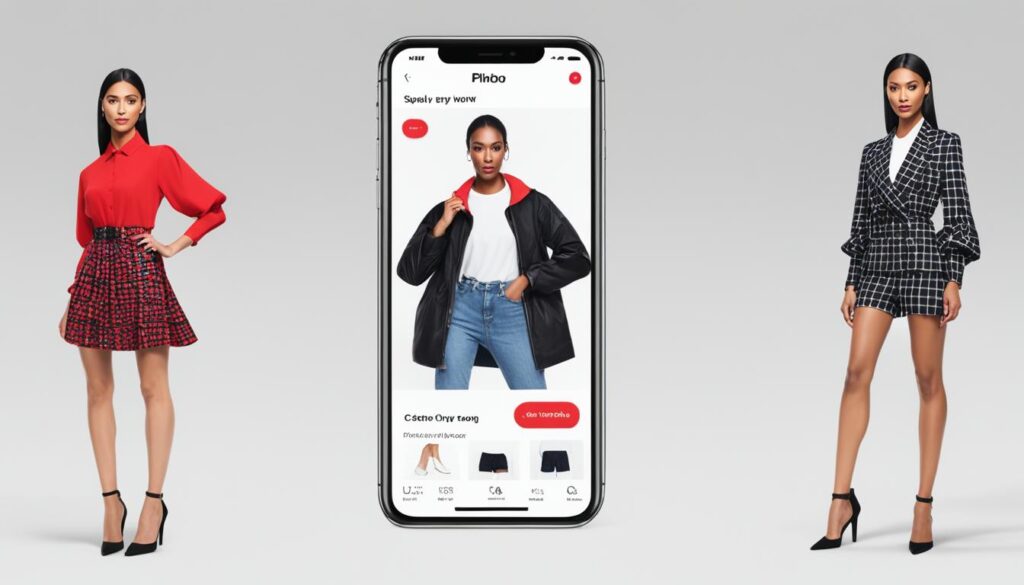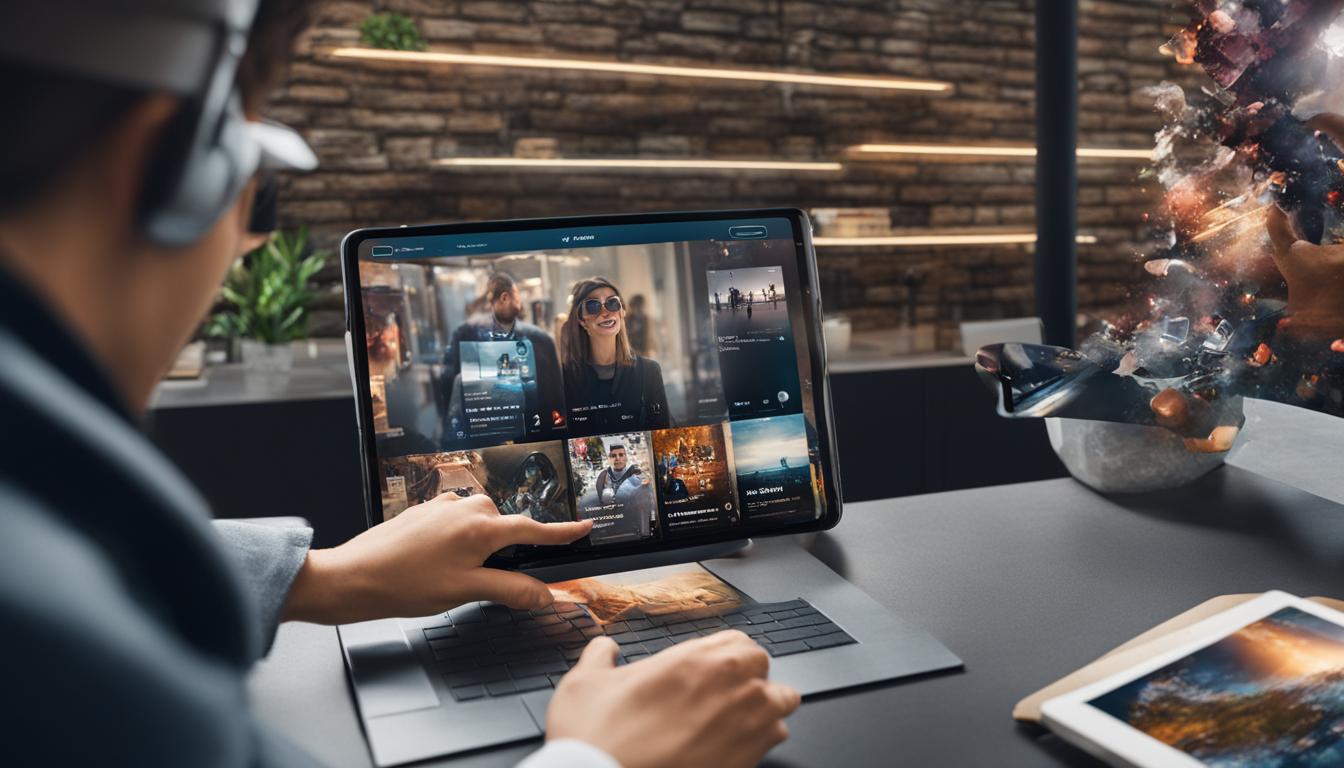Augmented reality (AR) is an exciting technology that is revolutionizing the way we consume media. By seamlessly integrating digital elements into our real-world surroundings, AR enhances our media experiences and transforms the media landscape. From social media platforms to marketing strategies, AR is making its mark in the media industry.
Contents
- 1 The Influence of AR on Social Media Marketing
- 2 AR’s Impact on the Digital Commerce Context
- 3 AR’s Impact on Social Media
- 4 Conclusion
- 5 FAQ
- 5.1 How is augmented reality going to change the way we consume media?
- 5.2 How is AR technology impacting the media industry?
- 5.3 How is AR changing the media landscape?
- 5.4 What is the role of AR in social media marketing?
- 5.5 How is AR impacting the digital commerce context?
- 5.6 How is AR being used in social media?
- 5.7 What is the future of AR in social media?
- 6 Source Links
Key Takeaways:
- Augmented reality is changing the way we consume media by integrating digital elements into our real-world surroundings.
- Social media platforms like Snapchat and Instagram are leveraging AR to provide users with engaging experiences through filters and lenses.
- Brands are using AR to enhance their marketing strategies by offering virtual try-on experiences and immersive content.
- AR is transforming the digital commerce context, particularly in mobile shopping, by enhancing the consumer experience.
- The future of AR in social media holds promise for brand promotion, immersive environments, and unique user experiences.
The Influence of AR on Social Media Marketing
Augmented reality (AR) is revolutionizing social media marketing, offering brands new avenues to engage users and create immersive experiences. With the incorporation of AR functionality on platforms like Snapchat and Facebook, businesses can seamlessly integrate AR into their marketing strategies, enhancing user engagement and delivering captivating content.
One notable example of AR in social media marketing is Sephora’s implementation of AR on Facebook. By leveraging AR technology, Sephora allows customers to virtually try out their cosmetics products. This immersive user experience enhances the customer journey, empowering shoppers with the ability to make more informed purchasing decisions while enjoying a seamless online shopping experience.
In addition to cosmetics brands, news organizations like the New York Times are utilizing AR to provide users with immersive storytelling experiences. By leveraging AR functionality, they transport users into captivating narratives and enhance audience engagement.
AR is revolutionizing the way brands engage with their audience. Marketers can create customized branded filters using AR, enabling users to interact with their brand and capture memorable moments. These shareable experiences not only increase brand awareness but also foster stronger connections between brands and consumers.
AR also offers exciting opportunities for businesses operating in the fashion and retail sectors. With AR, customers can virtually “try on” clothing and accessories, eliminating uncertainties and facilitating a more satisfying shopping experience.
Overall, AR is transforming social media marketing by enabling brands to deliver immersive user experiences, enhance engagement, and create memorable interactions that forge deeper connections with their audience.
Example of AR Implementation in Social Media Marketing:
AR’s Impact on the Digital Commerce Context
Augmented reality (AR) is leaving a significant impact on the digital commerce context, especially in mobile shopping. When it comes to AR in mobile shopping, consumers’ responses are shaped by a variety of factors, including media richness, interactivity, telepresence, utilitarian value, hedonic value, and task complexity.
Research studies reveal that media richness and interactivity positively influence telepresence, which, in turn, affects consumers’ behavioral intentions based on their perceived utilitarian and hedonic values. The impact of interactivity on telepresence and the impact of telepresence on utilitarian value are particularly higher for consumers with a low perception of task complexity. On the other hand, the impact of telepresence on hedonic value is higher for consumers who perceive a high task complexity.
This valuable research provides insights for mobile retailers looking to leverage AR technology to augment the overall consumer experience and drive behavioral intentions in the digital commerce context.
| Factors Influencing Consumers’ Responses to AR in Mobile Shopping | Effect on Telepresence | Effect on Utilitarian Value | Effect on Hedonic Value |
|---|---|---|---|
| Media Richness | Influences telepresence positively | Higher impact | – |
| Interactivity | Influences telepresence positively | Higher impact for consumers with low task complexity perception | – |
| Telepresence | – | Influences behavioral intentions through perceived utilitarian and hedonic values | Influences hedonic value more for consumers with high task complexity perception |
By understanding the impact of various factors, mobile retailers can strategically implement AR technology to create immersive and personalized shopping experiences, ultimately influencing consumers’ decision-making process and driving their intentions.
Image:
AR’s Impact on Social Media
Augmented reality (AR) has become deeply intertwined with social media platforms like Snapchat, Instagram, and Facebook. These platforms offer a range of AR features, including filters and lenses, that allow users to enhance their posts and create interactive AR experiences.
Brands have recognized the power of AR in social media and are leveraging this technology to engage their audience in unique and exciting ways. For example, they can create virtual stores on social media platforms, enabling consumers to try out products virtually before making a purchase directly online.
AR also has the potential to revolutionize live events by allowing users to attend and engage with them virtually. Imagine virtually attending a concert and experiencing interactive AR elements that enhance the event’s atmosphere. Such immersive experiences can create a strong and lasting connection with the audience.
Another way brands are utilizing AR in social media is through the use of AR videos. These videos provide interactive and informative content, enabling brands to showcase their products, provide tutorials, or offer behind-the-scenes glimpses of their operations.
Furthermore, the shareability of AR experiences on social media enhances brand awareness. Users are inclined to share their AR-filtered photos or videos, thereby spreading the brand’s reach and generating user-generated content.
As AR technology continues to evolve, its impact on social media is expected to expand. Brands and marketers will have new opportunities to engage their audience, enhance brand visibility, and create memorable experiences that resonate with users.

Immersive Environments and Interactions
Brands can create immersive environments in social media by offering interactive AR games or experiences. These engaging experiences captivate users, providing them with a unique and memorable encounter with the brand. Interactive AR games, quizzes, or challenges not only entertain users but also increase brand engagement, encouraging users to spend more time interacting with the brand and its offerings.
AR Videos for Captivating Content
AR videos are a powerful tool for brands to showcase their products, provide tutorials, or give users a firsthand glimpse into the experience of using their offerings. By incorporating AR technology in their video content, brands can create interactive and captivating experiences that stand out in a crowded social media landscape. These AR videos not only provide valuable information but also inspire users to share their experiences, resulting in increased brand awareness and organic promotion.
Brand Awareness and User-Generated Content
AR experiences are highly shareable, making them an effective tool for increasing brand awareness. Users who have an engaging AR experience are likely to share it with their audience, amplifying brand visibility and reach. Additionally, AR can inspire users to create user-generated content featuring the brand, further enhancing brand awareness and driving social proof.
In conclusion, augmented reality has the potential to revolutionize brand promotion, enhance brand engagement, and create unique and memorable experiences for social media users. As AR technology continues to evolve, brands should leverage these opportunities to stay ahead of their competition and deliver immersive and captivating experiences to their audience.
Conclusion
Augmented reality (AR) is poised to revolutionize social media and transform the way we consume media. With its integration into popular social media platforms, AR provides users with immersive and interactive experiences that captivate their attention and engage their senses. As a result, brands are capitalizing on the power of AR to enhance their marketing strategies and create unique, unforgettable experiences for their audience.
The future of media consumption will be shaped by the evolution of AR technology. As AR becomes more accessible, it will open up new avenues for brand promotion and the creation of immersive environments for users. Brands can leverage AR to provide virtual try-on experiences, allowing consumers to test products before making a purchase. They can also create interactive AR games or experiences that provide a deeper level of brand engagement. Furthermore, AR videos can be utilized to showcase products, provide tutorials, and offer a glimpse into the user experience, capturing the attention of social media users and increasing brand awareness.
As AR continues to advance and gain popularity, its impact on social media and the changing media landscape will only grow. Users can expect to see even more innovative uses of AR in their favorite platforms, as the technology opens up new possibilities for immersive content. The future of media consumption will be characterized by enhanced brand promotion, immersive experiences, and a fundamental shift in the way we engage with content. As AR becomes an integral part of our social media experience, it will reshape the way we interact with brands, bringing us into a new era of media consumption.
FAQ
How is augmented reality going to change the way we consume media?
Augmented reality (AR) has the potential to revolutionize media consumption by integrating digital components into our field of view, enhancing reality, and providing unique, engaging experiences.
How is AR technology impacting the media industry?
AR is already making an impact on social media platforms, such as Snapchat and Instagram, where users can use AR filters and lenses to enhance their posts. Brands are also leveraging AR to enhance their marketing strategies, allowing users to try out products virtually and providing immersive experiences that increase brand awareness.
How is AR changing the media landscape?
AR is transforming the media landscape by offering new ways for brands to engage with their audience and create immersive environments. It is being integrated into social media platforms, enabling virtual try-on experiences, interactive AR games, and immersive AR videos.
AR is revolutionizing social media marketing by providing brands with new ways to engage users and create immersive experiences. Platforms like Snapchat and Facebook have incorporated AR functionality, allowing brands to integrate AR into their marketing strategies, enhancing the customer experience, and speeding up the decision-making process.
How is AR impacting the digital commerce context?
In the context of digital commerce, AR is influencing mobile shopping experiences. It enhances the consumer experience, influences behavioral intentions, and affects factors such as media richness, interactivity, telepresence, utilitarian value, hedonic value, and task complexity.
AR is closely intertwined with social media platforms like Snapchat, Instagram, and Facebook. These platforms offer AR filters and lenses that allow users to enhance their updates and create AR experiences. Brands can utilize AR to create virtual stores, offer try-on experiences, and video content to showcase products.
The future of AR in social media looks promising, as it offers new ways for brands to promote themselves and engage with their audience. It enables virtual try-on experiences, immersive environments, interactive AR games, and shareable AR experiences, increasing brand awareness and user engagement.
Source Links
- https://www.forbes.com/sites/lilachbullock/2018/11/16/ar-and-social-media-is-augmented-reality-the-future-of-social-media/?sh=783c34dae141
- https://socialthrive.com/2022/09/how-augmented-reality-ar-will-impact-the-future-of-social-media-marketing/
- https://www.ncbi.nlm.nih.gov/pmc/articles/PMC9981924/




